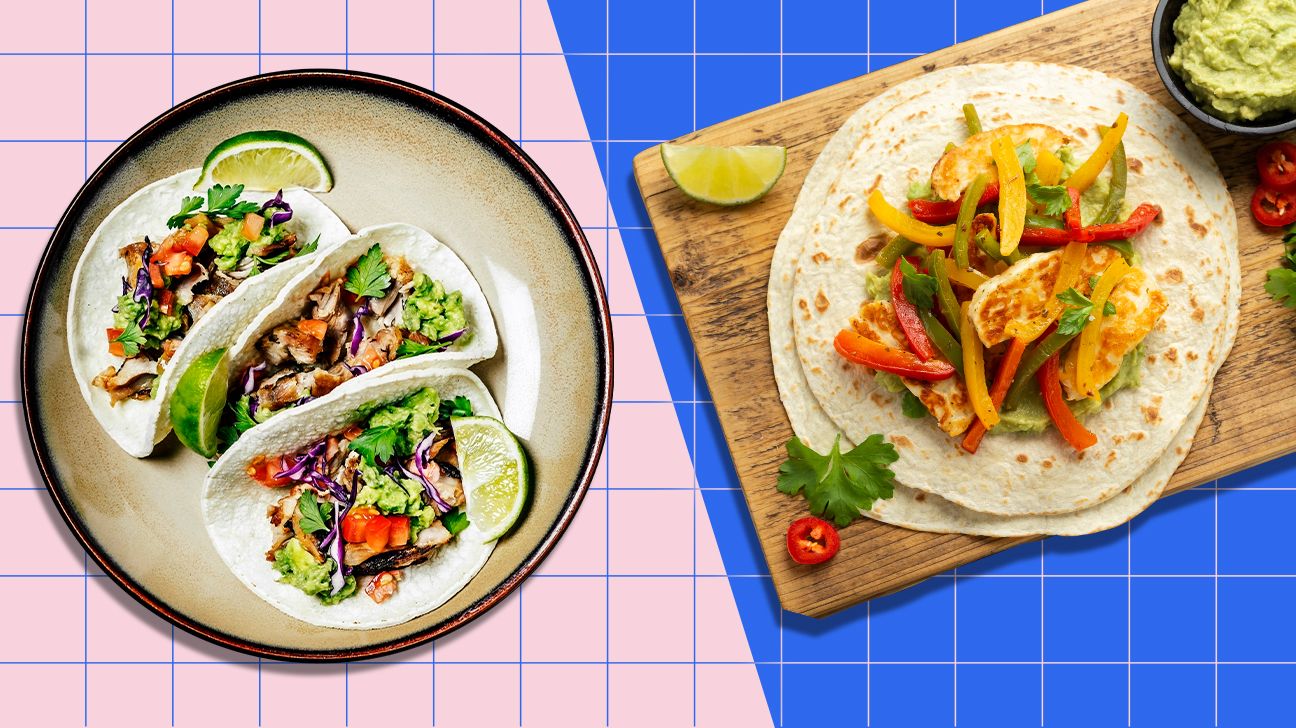Lumping together fajitas and tacos is like saying apples and apple pie are basically the same thing. Yes, they both involve fruit. But one is the party favor, and the other is the whole fiesta. The confusion lies with the fact that fajitas and tacos both have meat inside tortillas with toppings such as salsa, pico de gallo, guacamole, cheese, and sour cream.
“Fajitas are the actual filling. Traditionally, it was carne asada, a skirt steak. It’s cut into strips because it’s a tougher cut of meat. You have to slice it against the grain, and it’s cooked over a grill, traditionally marinated first, but how you marinate it is up to your personal preference,” says Carino Cortez, a graduate of the Culinary Institute of America in Hyde Park who studied with Rick Bayless for three years, and chef and general manager of Viva Villa Taqueria in San Antonio, Texas. Cortez’s grandfather opened Mi Tierra Café and Bakery in 1941, which is celebrating its 75th anniversary. The original of four Cortez family restaurants, Mi Tierra is credited with being the first restaurant to bring sizzling fajitas to the U.S. from northern Mexico, which is known for its grilled meats. “We brought the showy element to it,” Cortez says.
Fajitas cause heads to turn as they float by. At Mi Tierra, the sizzling fajitas arrive loud with plumes of steam billowing from the black cast iron skillet protected by a wooden platter underneath. While tacos come to the table already filled with meat, fajitas are compiled by diners at the table. The customer chooses between soft corn or flour tortillas, both 6.5-inches in diameter and served separately from the skillet meat. Grilled chicken strips are a more modern take on fajitas. Skirt steak was used originally because it was the cheapest cut of meat. “So you could get a giant slab and feed a crowd and have a party,” Cortez says. Compared to the ease and portability of tacos, fajitas are more of an event.
The term “fajita” literally means “little sash,” the diminutive of the Spanish word faja, meaning “belt, strip, or band,” according to the 2016 Random House Dictionary. A taco is defined as an (often crisply fried) tortilla folded over and filled with seasoned chopped meat, lettuce, tomatoes, and cheese. The word comes from Mexican Spanish, meaning literally “wadding, plug.”
“A taco is kinda like a sandwich,” says Jody Lancarte, special events and catering manager as well as granddaughter of the namesake of Joe T. Garcia’s Mexican Restaurant, one of the oldest Mexican eateries in Fort Worth, Texas. It has been family-owned and operated since 1935. “A taco can be made out of anything: eggs, beans, whatever. You can put everything under the sun in a taco,” Lancarte says.
The meat in fajitas usually mingles with grilled or sauteed peppers and onions, which are cut into similarly sized strips. In tacos, the vegetables are often chopped or sliced and kept raw as a topping. “You can have fajita tacos,” Lancarte says. “We have fajita nachos.” Joe T. Garcia’s tacos are corn tortillas wrapped with different meat fillings, held together with toothpicks in the kitchen until ordered by a customer. Then the tacos are fried and topped with shredded lettuce and diced tomato.
In actual Mexican cuisine, there is no crispy tortilla, Cortez says. They toast the tortilla in oil, but it doesn’t become a hard, folded-over shell. They’re known as tacos dorados. Flour tortillas are mostly in northern Mexico and used for fajitas. Her family’s restaurants make their own corn and flour tortillas. In traditional Tex-Mex cooking, you can have a soft flour taco or a pre-made crispy corn taco shell. “They’re the ultimate vehicle,” Cortez says.
Hankering for some tacos or fajitas yet? We are (taco dinner plans are already in the works)! Try some of our recipes for fajitas and tacos — we have more than 80 versions combined.
1. Grilled Skirt Steak Fajitas
Make your fajitas the way they were made originally: with skirt steak. You marinate it 8 hours or overnight so the meat is infused with zingy flavor. Try our grilled skirt steak fajitas recipe.
Chile-marinated pork and pineapple make these tacos savory, spicy, and sweet. Oh, what a threesome. Get our tacos al pastor recipe.
This is definitely a modern take on traditional fajitas, but it’s still got those bell peppers and onions, as well as real Mexican cheese, or cotija. Why not mix it up and use heart-healthy, flavorful salmon? Get our salmon fajitas recipe.
4. Chorizo and Potato Breakfast Tacos
Spicy Mexican pork sausage with scrambled eggs and potatoes makes a hearty, hot (in both senses of the word) filling for tacos in this breakfast version. If tortillas are like bread in Mexico, why not have them as your morning toast? Get our chorizo and potato breakfast tacos recipe.
Chicken fajitas don’t have to be marinated a minimum of eight hours like skirt steak does. You can do it as little as 10 minutes, but the closer to 24 hours you do, the more flavor you’ll get. Expect all the great flavors from garlic, cilantro, cumin, chili powder, and coriander. Get our basic chicken fajitas recipe.
6. Grilled Shrimp Tacos with Avocado-Corn Salsa
Skewer 2 pounds of shrimp and lay them on the grill for a taco party of six or eight using this recipe. This is a welcome change to the typical chicken, beef or pork taco. Plus it’s refreshing, savory, creamy and crunchy. Get our grilled shrimp tacos with avocado-corn salsa recipe.

